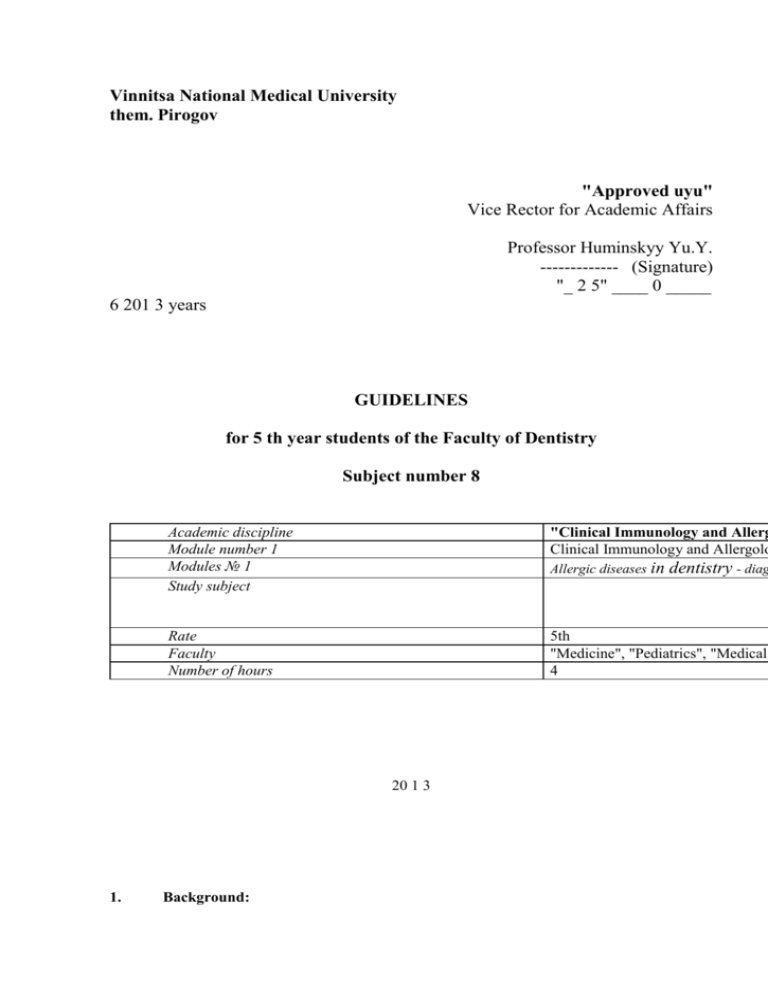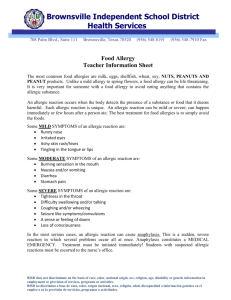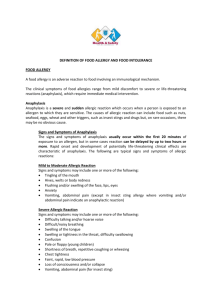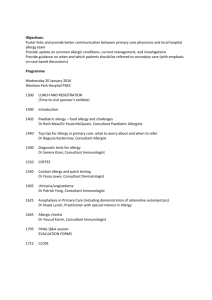Vinnitsa National Medical University them. Pirogov "Approved uyu"
advertisement

Vinnitsa National Medical University them. Pirogov "Approved uyu" Vice Rector for Academic Affairs Professor Huminskyy Yu.Y. ------------- (Signature) "_ 2 5" ____ 0 _____ 6 201 3 years GUIDELINES for 5 th year students of the Faculty of Dentistry Subject number 8 Academic discipline Module number 1 Modules № 1 Study subject "Clinical Immunology and Allerg Clinical Immunology and Allergolo Rate Faculty Number of hours 5th "Medicine", "Pediatrics", "Medical 4 Allergic diseases in 20 1 3 1. Background: dentistry - diag In modern terms allergies (AZ) are among the most common diseases among the population and account for a large medical and social problem. From 15.0% to 35.0% of the world population suffering from AZ.On the background of the general rise in allergic diseases genesis growing number of allergic reactions (AR) on uzhalennya Hymenoptera insects (bees, wasps, hornets). Yes, 0,4-4% of the population suffers from increased sensitivity to Hymenoptera stung, and stung by insects mortality ranged from 0.09 to 0.45 deaths per million population. In the development of allergy to Hymenoptera venom important role played by repeated multiple uzhalennya insects. Therefore, beekeepers and their family members are at the highest risk of AR in uzhalennya. Prevalence of insect allergy (IA) in this population ranges from 15% to 43%. The problem of adverse reactions, including allergic origin, and the use of diagnostic drugs is very important. According to published data, they are found in 10-20% of the population, 3% of the reason for going to doctors, 5% - the reason shpytalizatsiyi, 3% - leads to the ICU, 12% - resulting in significantly longer stay hospital, 1% can cause mortality and this indicator occupy 5th place after cardiovascular, cancer, bronchopulmonary diseases and injuries. A similar situation occurs in the Ukraine, where, according to local researchers (official statistics on this is not), the incidence of drug allergy (MA) population varies in the range of 1-2% and, in theory, could lead to the deaths of 100-2000 drug-induced anaphylactic cheek (MASH) annually. Most real causes of anaphylaxis are medicinal, insect and food allergies. In the USSR, with poorly-functioning registration anaphylactic reactions during the period from 1970 to 1980 was officially recorded 520 you cases of anaphylactic shock, with 48 deaths (9.2%), which accounted for about 1 in 5 million per year. Ontario (USA) recorded 4 cases of shock by 10 million people in Munich (Germany magnitude of) - 79 cases per 100 thousand population. In the U.S., anaphylaxis registration ruyetsya 1 in 3000 patients, which causes about 500 deaths you cases of a year. 2. Learning Objectives (main teaching and learning issues for self pozaudytornoyi). Know how to: 1. Predict occurrence of AF in patients who have used drugs (drugs). 2. Conduct medical history, interpret clinical symptoms and laboratory signs of AI, insect allergies. 3. To be able to formulate a diagnosis and carry out differential diagnosis between the various forms of no tolerance of drugs (including real and apparent allergic reactions to drugs). 4. Diagnose MA and insect allergies and n vivo and in vitro. 5. Treat MA and provide immediate assistance with medical anaphylactic shock (MASH). 3. Be able to: 1. Collect allergy, pharmacological and medical history of the patient, which are administered drugs. 2. Conduct skin testing (prick test) with solutions of drugs. 3. Provide first aid in MASH. 4. Baseline training. The names of the preceding disciplines 1. Human Anatomy 2. Normal physiology These skills are Skin and mucous membranes o Appropriate reaction to the use 3. Physiopathology 4. Pharmacology 6. Otorhinolaryngology 7. Internal Medicine Inadequate reaction to the use Pharmacokinetics of drugs, the The phenomena of allergic rhin Attack of asthma emergency c 5. Organization of the content of teaching material The teacher introduces students to the problem of side effects of drugs and explains that, because of the doctrine of chemotherapy disease that prevails in medicine, each destination drugs that will make a future doctor, may pose a risk to health, "I and the life of the patient. Then the instructor shows patients with a history or clinical signs of AI (absence - the relevant clinical examples and pictures). During the demonstration patients teacher points out that complications of chemotherapy could not be if doctors previously included circumstances with appropriate patients. The following draws attention to the different nature and mechanism of adverse reactions to drugs that require different pihodiv to the examination and treatment of patients. It is proposed to raise students several pharmacological allergy history of patients: The range of questions aimed at identifying and contingent risk for AF 1.Chy taken before farmakopreparaty, passed invasive examination 2.Chy often took drugs, which was the duration of treatment 3.What drugs received (with special attention paid to the antibiotics, anesthetics, intravenous, inhaled, Application administration of drugs) 4.Chy have undesirable effects on intake of medications (drugs) and what they manifest: special attention should be paid to loss of consciousness, low blood pressure, sverbinya and rashes on the skin of redness, swelling, discharge from the nose appearance, red eyes, their itching, bronchospasm phenomena 5.Chy there were such things in the first intake of drugs (unless they had not taken ill) or it occurred after 5-7 days of treatment and more 6.Chy he suffers allergies or hurt them his parents are blood relatives; 7.What he have other chronic diseases (particular attention should be paid to autoimmune, kidney, liver and gall bladder, stomach and intestines, pancreas) 8.Chy a patient occupational hazard of sensitizing properties (special attention should be paid to work in pharmacies, hospitals, biotech companies) 9.Chy are foods, food additives, which can not tolerate the patient (special attention should be paid to animal products, additives indefinite composition and origin) Writing in an outpatient or inpatient map that the patient aware of the manipulation, which he shall carry out, or the nature of the treatment and drugs that he should appoint (give him the opportunity to learn about their possible side effects and obtain the signature of informed consent and manipulation treatment). If there is an urgent need for prescribing pharmacotherapy patient who for various reasons can not give such consent, such consent must be obtained from his relatives or commissions iyne prescribing or diagnostic procedures. In a survey conducted patients should be required "necessarily tailored to suit toxic false-allergic and allergic reactions to drugs The next stage is conducted in sessions of manipulation, where the skin tests with solutions of drugs. Each student can spend setting prick test with histamine solution and the partner to assess the test. The following lists the (better - to show it in the laboratory) laboratory methods that can be applied to identify drug-allergen. The final phase will be done in class where students clearly lists the steps to assist the patient with MASH. 6. Plan and organizational structure of educational classes Allergology (240 minutes). Number c/o Stages classes Distribution time * 1. 1.1. The preparatory phase Organizational matters. 35 min 5 min 1.2. Formation of motivation 5 min 1.3. Control of entry level of training (Standardized controls). 2. The main stage (specify all kinds of work that students perform under during this phase). Types of Monitorin practica Familiarity wi students students with the Structured wr 25 min 120 min Oral survey poll by standa analysis of the of objective examination. test control criteria of kno 3. The final stage 25 min 3.1. Control endline training. 15 min 3.2. Overall training student activities. 3.3. Informing students the topic of the next session. 5 min 5 min Note: * Forms of control and training tools specifically defined by the Department for each stage of training; Theory Controls ** theoretical and practical training of students need to be standardized. 7. Methods of educational process in the practice (seminar) class. 7.1. The preparatory phase. Features of the clinical examination of patients with AF: complaints, allergy and pharmacological history, progress, methods of skin and laboratory tests. Features of the clinical examination of patients with insect allergy: complaints, allergy and namnez, motion, methods of skin and laboratory tests. To acquaint students with specific goals and plan lessons. Conduct initial control level of training students in an objective examination of the patient with AF. Determine the level of training on issues of insect allergy. 7.2. The main stage This phase involves performing each student independently and under the supervision of the teacher below mentioned practical work. Task 1 Students carry out an objective medical history and examination of patients with AF and th insect allergy. Then, students spend one single trestuvanya skin (prick test) to test the control liquid or solution of histamine. Task 2 Number 1. Task What is the likelihood of AF in patients with designated drugs? 2. 3. 4. 5. 6. 7. 8. 9. 10. 11. 12. 13. 14. The prevalence of AF in Ukraine? Clinical manifestations of MA? Frequently proya and in MA? The most dangerous manifestation of MA? The longest period that can occur due to AI? Does the emergence of AI doses of the drug? Do all patients MASH has the same course? Do all patients before prescribing drugs should be should be skin tested? Is it possible to carry out skin tests with drugs, previously called MASH in this case? How can we interpret skin tests with solutions of drugs? What reactions happen in inseketniy allergies? How sick it is advisable to carry out CIT in insect allergies? What is the diagnostic method to distinguish toxic reactions to insect uzhalennya of insect allergy? Task 3 Solve tests: 1. If skin testing with a solution of drugs had a positive response to all three solutions. How can we interpret this reaction? The answer - as unreliable. 2. Manifestation of AI with 4 type of immune response? Answer - type of contact dermatitis 3. Is full of drugs allergens? The answer is - no, they are bilshostoi hapten - inferior allergens which become full of character with allergen only in "communion with serum albumin. 4. What input method is the safest drugs that - the most dangerous? From the response - respectively, oral, dermal and inhalation 5. Is it appropriate administration of antihistamines after uzhalennya Hymenoptera? Reply id - only with normal blood pressure. Task 4 Challenges to self: №/№ 1. Task Type of immune response in allergic rhinitis as a manifestation MA 2. 3. 4. Type of immune response in drug hemopatiyah Parenteral antihistamine What is lacking in adverse drug reactions psevdoalerhichnyh? 5. What is a skin test is the most common diagnosis in skin MA? 6. The first event in the event MASH 7. Could be the first MA use drugs? 8. Is there a dose-dependent MA? 9. Can I use drugs, which have an allergy to antihistamines background? 7.3. The final stage. We estimate the current activities of each student during class, the analysis of student achievement, announced evaluation of each student and put in the log of visits and student achievement. Group leader at the same time puts assessment roll of the success and attendance of students, teacher assures them his signature. It is advisable to briefly inform students about the topic of the next lesson and instructional techniques to prepare for it. 8. Applications. 8.1. Theoretical questions preparatory phase: 1. Features collection allergy and pharmacological history to prevent AF. 2. The main complaint in patients with clinical signs of AI and AI. 3. Skin test as a screening method for etiologic diagnosis of MA. 4. History taking, methods of diagnosis and treatment of insect allergy. 5. Providing emergency care for MASH. Typical task level II Zadacha1. The nurse complains of itching, redness, skin cracks, lihenifikatsiyu that occur one day after exposure to antibiotics penicillin group. The diagnosis of allergic contact Derm and Titus. What type of allergic reaction takes place?What should advise patients? The standard answer. 1. Delayed-type hypersensitivity. 2. Change profession or go to work, not bound with drugs. Problem 2. When removing a tooth in the dental office after entering lidokainu the patient appeared the following symptoms: abrupt late and hardness of the skin, mucosal cyanosis, cold sweats, shortness of breath. Your diagnosis? What measures should be implemented and how quickly? The standard answer. 1. A nafilaktychnyy shock. 2.Nevidkladno should conduct protyshokovi events. Problem 3. After bee sting in lopchyka's 11 years of "appeared itchy skin, hoarseness of voice, barking cough, restlessness, swelling of the lips, eyelids, cyanosis, rash itchy blisters. Which of the drugs used in the first place? Key Answer. A drenalinu hydrochloride. Problem 4. The girl of 4 years with the introduction of penicillin there was burning sensation, redness of the skin, anxiety, fear of death, headache, buzzing in your ears, chest pain, blood pressure - 60/30 mm Hg .. c. The introduction of the drug stopped, provided first aid. What type of allergic reaction has taken place? The standard answer. EAG P and the new (immediate hypersensitivity type) Problem 5. The child am 15 years old, suffering from bronchial asthma and atopic dermatitis indication in the history of drug allergy is not observed. However, after instillation into the ear 2 drops of aqueous furatsillina about joining right-otitis, 5-7 minutes. was itching, redness, swelling of the right ear, face and neck. From history it appeared that the girl in the past, the drug often used as a lotion on dermatitis. ARISING to the child? Treatment and recommendations? The standard answer. As a child there is an acute allergic reaction in the form of angioedema in furatsillina. Recommended: permanently abandon the use furatsillina appoint parenteral antihistamines 1st generation, system ACS 1mh/kh rate of loss. Problem 6. Employee tannery was introduced tetanus serum ka. After 7 days he developed fever, increase in lymph political units, generalized urticaria, swelling, pain in the joints. The standard answer. Yrovatkova C disease. Tasks III level Zadacha1. Against ARI in patients who received sulfa drugs, not steroid anti-inflammatory agent, acidified beverages and Revit appeared maculopapular lesions on the skin, accompanied by itching and difficulty breathing. Therapy should include all of the options listed below, except: 1. Unlike all assigned agents 2.Antyhistaminnyh drugs 3. enterosorbents 4. Bronchodilators 5. Specific immunotherapy The standard answer. Specific immunotherapy Problem 2. A man in '37 during pyelography using verohrafinu appeared itchy skin, swelling of the face, dizziness, fear of death. BP 70/40 mm Hg., PS 130 beats per minute .. Noisy breathing, wheezing heard in th e state, auscultation of breath relaxed, single dry rales. Diagnosis? What preparation is necessary to enter the patient first? The standard answer. 1.Anafilaktychnyy shock. 2.Adrenalin. Problem 3. The patient in history - angioedema after treatment with antibiotics penicillin series. When the need for antimicrobial therapy is not recommended to prescribe the following groups: 1. Aminoglycosides 2. Macrolides 3. Tsefalorsporyny 4. Fluoroquinolones 5. Sulfonamide Key Answer: cephalosporins Problem 4. By the induction center delivered a patient 22 years old, who after extractions \ tooth swelling appeared on his face and within 2 hours spread to the neck, chest, upper limbs. Swelling pale, tight, am provodzhuvavsya itching and hives. After the introduction of antihistamines and corticosteroids the patient's condition is not Better. What are the possible causes of edema? Key Answer: C1-inhibitor deficiency of complement 4. Make yourself algorithm examination of the patient with suspected MA. 9. Suggested Reading: General: 1. Drannyk GN Clinical ymmunolohyya and allerholohyya. - Kiev: Polyhrafplyus, 2006. - 482 p. 2. Lopatin AS Pharmaceuticals anafilakticheskom shock. - Moscow: Medicine. - 1983. - 159 p. 3.Medykamentozna allergy: the state of the problem of organization identification, diagnosis, prevention and treatment - Guidelines. - C. 2008. - 32. 4. Novikov DK, Sergeev YV, PD Novikov Lekar stvennaya allerhyya. -M. , 2001. - 313 p. 5. Puhlyk BM Allergy. - Kiev: New Book, 2004. - 240 p. Learn more: 1. Zmushko, Belozerov ES. Medykamentoz WIDE complications. - Ed. "Peter", 2001. - 425 p. 2. Clinical allerholohyya / P from Ed. RM Khaitov. - Moscow: MEDpressynform, 2002. - 624 p. 3. Patterson, R., Hrэmer L, Greenberg P. Allerhycheskye illness (diagnosis and Treatment). M.: "Heotar." - 2000. - 734 p. 4. Protocols of care for patients with allergic disease. Association allergists Ukraine. - Kyiv, Vinnytsia., 2007. - 40 p. 5. Puhlyk BM Abstract allerholoha. - Kiev: ichi, 2008. - 95. 6. . Sergeev YV C ovremennaya classification dasg allerhyy / / Lechaschyy doctor. - 2001. - number 3. - S. 22-32. Guidelines prepared by IV Korytska Guidelines approved at a meeting of "25" 6 0 "201 3 , the protocol number 1 Loading iduvach k afedr and MD Professor BM Puhlyk Associate






